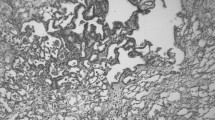Abstract
The use of the antiarrythmic drug amiodarone (AD) has been limited by the propensity of the drug to cause severe lung damage. AD has been shown to produce a transient pulmonary fibrosis in hamsters after intratracheal instillation. The goal of this study was to characterize the early inflammatory events associated with the administration of AD. Male Syrian hamsters that were instilled intratracheally with AD or saline vehicle underwent bronchoalveolar lavage (BAL). Total cells, macrophages, and eosinophils obtained by BAL were elevated by AD treatment at day 3. At both days 1 and 3 after instillation, AD-treated animals had significant elevations in neutrophil number. BAL fluid albumin was significantly elevated at day 1 in treated animals. Chemiluminescence (CL) performed on cells obtained by BAL showed an increase in CL of AD-treated samples compared to controls in phorbol myristate acetate (PMA) stimulated CL. PMA-induced increases in responsiveness were diminished by superoxide dismutase and catalase. These results indicate that oxidants such as superoxide and hydrogen peroxide may be involved in this inflammatory process. The results of this study show that intratracheal instillation of AD results in an inflammatory response that can be assessed by cellular, biochemical, and functional means.
Similar content being viewed by others
References
Akoun, G. M., H. Liote, B. J. Milleron, andC. M. Maynaud. 1987. Amiodarone lung.In Current Topics in Pulmonary Pharmacology and Toxicology. M. A. Hollinger, editor. Elsevier, New York. 176–194.
Rotmensch, H. H., M. Liron, M. Tupilski, andS. Laniado. 1980. Possible association of pneumonitis with amiodarone therapy.Am. Heart J. 100:412–413.
Mason, J. W. 1987. Amiodarone.N. Engl. J. Med. 316:455–466.
Martin, W. J., andE. C. Rosenow III. 1988. Amiodarone pulmonary toxicity.Chest 93:1242–1248.
Cantor, J. O., M. Osman, J. M. Cerreta, R. Suarez, I. Mandl, andG. M. Turino. 1984. Amiodarone-induced pulmonary fibrosis in hamsters.Exp. Lung. Res. 6:1–10.
Daniels, J. M., J. F. Brien, andT. E. Massey. 1989. Pulmonary fibrosis induced in the hamster by amiodarone and desethylamiodarone.Toxicol. Appl. Pharmacol. 100:350–359.
Henderson, R. F. 1991. Commentary on “Cellular and biochemical indices of bronchoalveolar lavage for detection of lung injury following insult by airborne toxicants” by M. Firoze Khan and G. S. D. Gupta.Toxicol. Lett. 58:235–238.
Martin, W. J., andJ. E. Standing. 1988. Amiodarone pulmonary toxicity: Biochemical evidence for a cellular phospholipidosis in the bronchoalveolar lavage of human subjects.J. Pharmacol. Exp. Ther. 244:774–779.
Wilson, B. D., A. J. Jaworski, M. E. Donner, andM. L. Lippmann. 1989. Amiodarone-induced pulmonary toxicity in the rat.Lung 167:301–311.
Lindenschmidt, R. C., K. E. Driscoll, M. A. Perkins, J. M. Higg, J. K. Maurer, andK. A. Belfiore. 1990. The comparison of a fibrogenic and two nonfibrogenic dusts by bronchoalveolar lavage.Toxicol. Appl. Pharmacol. 102:268–281.
Antonini, J. M., K.Van Dyke, Z.Ye, M.Dimatteo, and M. J.Reasor. 1994. The introduction of luminol-dependent chemiluminescence as a method to study silica inflammation in the tissue and phagocytic cells of rat lung.Environ. Health Perspect. 102 (Supl. 11) (in press).
Dedhia, H. V., J. Y. C. Ma, V. Vallyathan, N. S. Dalal, D. Banks, M. Billie, M. W. Barger, andV. Castranova. 1993. Exposure of rats to hyperoxia: Alteration of lavage parameters and macrophage function.J. Toxicol. Environ. Health 40:1–13.
Reasor, M. J. 1980. Cumene hyperoxide-mediated lipid peroxidation in rat alveolar macrophages following induction of phospholipidosis with chlorphentermine.Toxicology 18:159–168.
Van Dyke, K. 1987. Introduction to cellular chemiluminescence, neutrophils, macrophages, and monocytes.In Cellular Chemiluminescence, Vol. 1. K. Van Dyke and V. Castranova, editors. CRC Press. Boca Raton, Florida, 3–22.
Driscoll, K. E., J. K. Maurer, R. C. Lindenschmidt, D. Romberger, S. I. Rennard, andL. Crosby. 1990. Respiratory tract responses to dust: Relationships between dust burden, lung injury, alveolar macrophage fibronectin release, and the development of pulmonary fibrosis.Toxicol. Appl. Pharmacol. 106:88–101.
Harris, J. A., D. M. Hyde, Q. Wang, M. Y. Stovall, andS. N. Giri. 1991. Repeated episodes C5a-induced neutrophil influx do not result in pulmonary fibrosis.Inflammation 15:233–250.
Author information
Authors and Affiliations
Rights and permissions
About this article
Cite this article
Blake, T.L., Reasor, M.J. Acute pulmonary inflammation in hamsters following intratracheal administration of amiodarone. Inflammation 19, 55–65 (1995). https://doi.org/10.1007/BF01534380
Issue Date:
DOI: https://doi.org/10.1007/BF01534380




